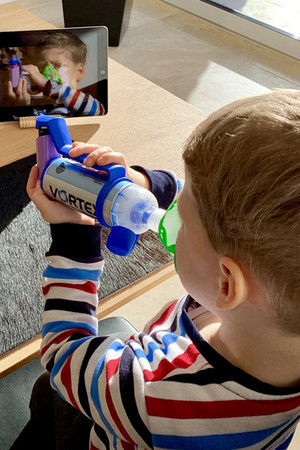
Inhalation using asthma sprays or other metered-dose inhalers in children is usually only successful with a spacer (inhalation chamber or holding chamber). The pneumologist for children, Dr Franziska Stieglitz explains in an interview why this is the case and what to watch out for when using an inhalation aid.
Dr Franziska Stieglitz: Basically, any child up to the age of about six to eight years who has to inhale a metered-dose inhaler or a spray because of asthma, obstructive bronchitis, a hypersensitive bronchial system or similar chronic lung disease should use an inhalation chamber.
Triggering the spray while simultaneously taking a deep breath is very difficult to coordinate. It requires practice in all age groups and most young children are not able to do this.
Using an inhalation chamber means that the child does not need to have this coordination skill. Children will inhale the drug properly if they use a spacer. The use of an inhaler is also recommended in older children who have delayed development. Children and adolescents with very restricted lung function should also use a spacer. They often no longer have the inhalation strength they need to breathe the inhalant deep into the bronchial tubes.
Dr Franziska Stieglitz: Because without an inhalation chamber, most of the drug would end up in the mouth, on the tongue, or in the throat, and so it would then not have the desired effect in the bronchial tubes. Children use the spacer to inhale airway dilating drugs, steroids and/or fixed combinations of bronchodilators and cortisone. The dose is adjusted to each patient. It is important that the prescribed dose of the drug reaches the bronchial tubes.
Dr Franziska Stieglitz: Absolutely. Especially in babies, it is important that the parents use a spacer for the child. The younger the child is, the more difficult it is to coordinate releasing the spray and breathing. The drug collects in the holding chamber so the child has time to breathe it in over several breaths.
The VORTEX holding chamber has several advantages when inhaling with babies. Firstly, the one-handed operation aid helps because parents only need one hand to hold and trigger the medication spray. The other hand is free to hold the child.
Secondly, there are mask attachments for the VORTEX. Babies and toddlers cannot cope with inhaling through a mouthpiece, because it has to be kept tightly sealed by the mouth during inhalation. If not, the medication escapes through the corners of the mouth into the air rather than reaching the bronchial tubes. This cannot happen with a mask. Parents hold the mask firmly sealing the nose and mouth for several breaths. This allows the medication to reach the lungs.
And thirdly, the VORTEX grows with the child. Masks are not only available in different sizes, but can also be replaced with a mouthpiece without having to buy a new VORTEX. The switch from a mask to a mouthpiece happens when the child is about three to four years old.
Dr Franziska Stieglitz: With babies and toddlers, you are faced with the problem that they start crying as soon as a stranger approaches them. In these cases, we demonstrate the handling and the spacer inhalation process using a hand puppet, a soft toy or a large doll. We take the doll on our lap and play through the process with the doll. Usually, children find that interesting and copy the inhalation with their parents.

Dr Franziska Stieglitz: It is basically easy to use an inhalation chamber. However, it is still important that children and parents are shown how they should use it for the inhalation and that they practise. In our practice we tend to show patients how a spacer works, even at the preliminary examinations. We demonstrate and then instruct the children or parents if they are using the inhalation chamber for the first time. We discuss and repeat the proper use of the spacer at every appointment, because sometimes mistakes creep in.
For example: Many children have to inhale two puffs. A common problem is that both puffs are released at the start of the inhalation therapy. The right way is to release one puff, then to inhale and only then to release the second puff and to breathe in again. Another mistake is made when switching from mask to mouthpiece. Parents and children sometimes do without the spacer and the child inhales the spray without a holding chamber although they do not yet have the coordination to do so.
Dr Franziska Stieglitz: If they do not use a spacer, most children spray the medication on their tongue or into their throat. Experience has shown that about 50 to 60 percent of the drug stays there, and so the effect is reduced accordingly. This takes its toll after a while and manifests as poorer respiration, endurance and lung function. This is why it is important to motivate children not just generally to inhale the spray but also to use a holding chamber.
Dr Franziska Stieglitz: It depends. There are drugs that taste very bitter. If a child does not want to inhale because of the taste, we look for an alternative drug that tastes better. If the child flatly refuses the inhalation, you should work with tricks and rewards. The child will then associate inhalation with a positive experience and will be more amenable to the therapy. Pressure and threats, on the other hand, tend to fail in most cases.
Dr Franziska Stieglitz: Yes, I would recommend that. It is especially important for children with asthma if they have to use the spray in the event of an asthma attack. When they have an asthma attack, their breathing is erratic and they may panic. This makes it all the more difficult to properly inhale the medication and for the entire dose to reach the bronchial tubes.
Dr Franziska Stieglitz, MD, has been working as a paediatric pneumologist for about 15 years, and for the last 10 years in a joint paediatric practice in Munich focused on paediatric pneumology and allergology.
Notes: The information in this blog post does not constitute a treatment recommendation. Patients’ needs are very different depending on their individual circumstances. The treatment approaches described here are intended to be examples only. PARI recommends that patients always consult with their GP or specialist.
The statements made in the interview are the individual views of the interviewee. They do not necessarily reflect the PARI view or the general state of science.
An article written by the PARI BLOG editorial team.
© 2025 PARI GmbH Spezialisten für effektive Inhalation